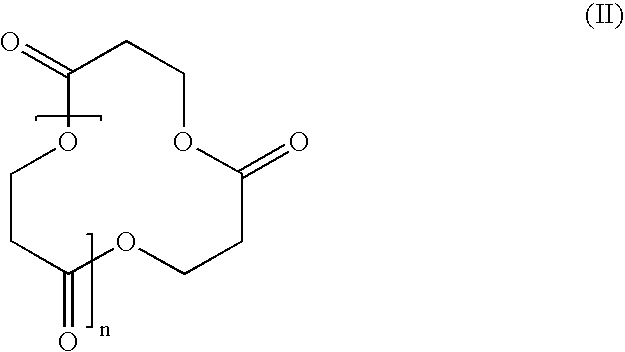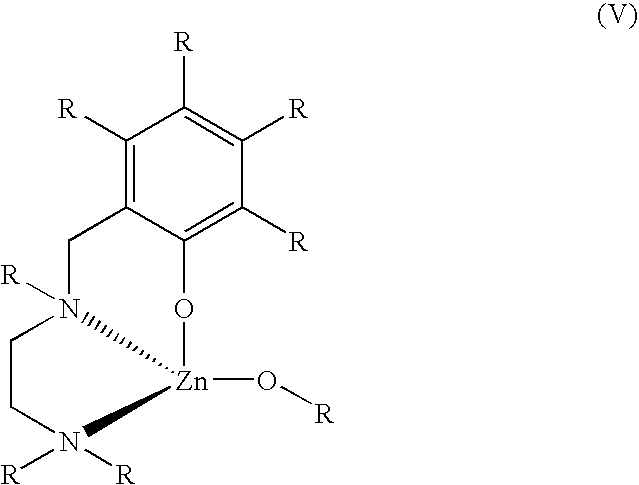Polymer synthesis from macrocycles
- Summary
- Abstract
- Description
- Claims
- Application Information
AI Technical Summary
Benefits of technology
Problems solved by technology
Method used
Image
Examples
example 1
Synthesis of 3-HP cyclic esters.
[0060] Commercially available aqueous solutions of 3-HP (20 wt%) were converted via acid-catalyzed (1-10 mol%) self-condensation with concomitant removal of water to a mixture of macrocycles and linear oligomers (Scheme 2). After limited optimization (Table 1), the macrocycles were isolated in good yield (60%) using a straightforward protocol.
TABLE 1Dependence of 3-HP cyclic esters' yield on reaction conditionssolvent[3-HP]0 (M)yield of 3-HP cyclic esters (%)benzene0.11-0.1520-29benzene0.0345toluene0.0360toluene0.1425
[0061] A round bottomed flask equipped with a Dean-Stark apparatus was charged with 3-hydroxypropionic acid (20 wt %) aqueous solution (80 g, 0.178 mol), p-toluene sulfonic acid monohydrate (2.5 g, 0.0131 mol) and toluene (1.3 L). The reaction mixture was refluxed for 2 days and ˜67 mL of water was removed azeotropically. The solution was allowed to cool to room temperature and filtered. The filtrate was concentrated to about 200-300 ...
examples 2 and 3
[0063] Use of the catalyst Sn(octanoate)2 in the presence of benzyl alcohol for the polymerization of a 3-HP trimer was not successful; no polymerization occurred in either solution state at room temperature (RT) or in the melt (70° C.) after 48 hours at high catalyst loadings.
example 2
Failed Synthesis of P[3-HP] with a Tin Catalyst in Solution.
[0064] A representative procedure for the failed polymerization of a 3-HP trimer by Sn(oct)2 and benzyl alcohol in solution state is as follows. In the glovebox, a vial was charged with 3-HP trimer (50 mg, 0.231 mmol) and CH2Cl2 (169 μL). A volume of the Sn(oct)2 stock solution (7.5 μL, 2.31 μmol) and a volume of benzyl alcohol stock solution (23.8 μL, 4.62 μmol) were injected into the monomer solution with stirring. The reaction mixture was stirred at room temperature for 48 hours. The reaction was quenched by exposure to the air outside the glovebox. The CH2Cl2 was removed in vacuo and the NMR spectra of the reaction mixture suggested that no reaction occurred.
PUM
| Property | Measurement | Unit |
|---|---|---|
| Temperature | aaaaa | aaaaa |
| Temperature | aaaaa | aaaaa |
| Temperature | aaaaa | aaaaa |
Abstract
Description
Claims
Application Information
 Login to View More
Login to View More - R&D
- Intellectual Property
- Life Sciences
- Materials
- Tech Scout
- Unparalleled Data Quality
- Higher Quality Content
- 60% Fewer Hallucinations
Browse by: Latest US Patents, China's latest patents, Technical Efficacy Thesaurus, Application Domain, Technology Topic, Popular Technical Reports.
© 2025 PatSnap. All rights reserved.Legal|Privacy policy|Modern Slavery Act Transparency Statement|Sitemap|About US| Contact US: help@patsnap.com



